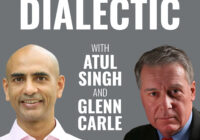What can a 1907 novel teach us about contemporary terrorism? [Read part one here.]
Now, turning to other themes in The Secret Agent, these seem, equally, downplayed in critical discussion of the novel, yet central to debates about contemporary terrorism. With respect to the latter, three terrorist incidents in London over the last generation will serve as examples: David Copeland’s two-week bombing spree during April 1999 targeting ethnic minorities and homosexuals, which killed three people and wounded 139 more; the jihadi Islamist attacks that killed 52 Londoners and wounded more than 750 on July 7, 2005; and the Woolwich murder of Drummer Lee Rigby on May 22, 2013, by the recently sentenced Michael Adebolajo and Michael Adebowale.
The latter have been described as a “lone wolf pack,” understood by Raffaello Pantucci as “small, isolated groups of individuals involved in terrorism,” whereby “some level of outside communication was apparent (mostly through the Internet), but at no point does it appear clear that the plotters were subject to the direction of outside forces.”
Lone Wolves
This naturally raises the definitional conundrum of what constitutes a “lone wolf.”
For one thing, the reinforcing, mutual incitement with multiple terrorists is much different than the psychological drive of an individual acting wholly alone. Like the understanding of “lone wolf packs” above, some of the broader definitions in this hotly contested area nonetheless imply that multiple people can carry out a “lone wolf” attack.
A quite recent example of this approach to lone-wolf terrorism was offered in a 128-word, mega-definition by the RAND analyst Jeffrey Simon’s 2013 book, Lone Wolf Terrorism: Understanding the Growing Threat:
“Lone wolf terrorism is the use or threat of violence or nonviolent sabotage, including cyber-attacks, against government, society, business, the military (when the military is not an occupying force or involved in a war, insurgency, or state of hostilities), or any other target, by an individual acting alone or with minimal support from one or two other people (but not including actions during popular uprisings, riots, or violent protests), to further a political, social, religious, financial, or other related goals, or, when not having such an object, nevertheless has the same effect, or potential effect, upon government, society, business, or the military in terms of creating fear and/or disrupting daily life and/or causing government, society, business, or the military to react with heightened security and/or other responses.”
Problematically, in the definition offered above, natural disasters could be considered the greatest lone-wolf terrorist of all.
Indeed, in Simon’s problematic rendering, the events recounted in The Secret Agent would undoubtedly be considered a “lone-wolf attack.” Yet the only people logistically involved in masterminding the failed bombing of the Greenwich meridian were the mastermind, Mr. Vladimir; his paid agent, Mr. Verloc; and a bomb-maker unaware of the actual target, The Professor, who only knew that “it was going to be a demonstration against a building.”
It seems the Woolwich killers were radicalized as much by the online Inspire magazine put out by the al-Qaeda “franchise” as they were via British foreign policy or religious extremism strictu sensu.
Based on testifying for Britain’s Crown Prosecution Service (CPS) against what I have elsewhere called “self-activating terrorists,” my own approach to so-called “lone wolf terrorism” seeks to be much more narrow:
“…self-directed political or religious violence undertaken through the ‘terrorist attack cycle’ by individuals — typically perceived by its adherents to be an act of asymmetrical, propagandistic warfare — which derives from a variable amount of external influence and context (notably now online), rather than external command and control.”
This focuses squarely upon individual motives and capabilities (not least those powered by the Internet today), rather than ex post facto perceptions by governments or others.
It would certainly exclude the case of the Woolwich murderers, for instance, who were able to rely upon each other for support and murderous fortitude, even if the traditional, hierarchical structure of a terrorist group like the Red Army Faction or the Irish Republican Army (IRA) were absent.
Both trends contrast starkly with the case of Copeland in 1999, whose actions were individually planned, self-targeted, single-handedly weaponized, and personally undertaken. In short, he went through the aforementioned “terrorist cycle” alone, without direct logistical or moral support from anyone else — an exemplary case of lone-wolf terrorism.
Broadband Terrorism
Nonetheless, scholars agree that, even if he never divulged his plot to them, Copeland was radicalized by his involvement with the extreme right British National Party (BNP), which he joined in 1997, then led by the uncompromising neo-Nazi John Tyndall. He briefly acted as a steward for the BNP, before leaving for the more extreme National Socialist Movement (NSM) — ostensibly on account of the latter’s willingness to countenance illegal violence and paramilitary action.
Much of his bomb-making was sourced via the Internet, in one of the first cases of what I have elsewhere called “broadband terrorism” — a phenomenon now ubiquitous for terrorists of all stripes today.
Similarly, it seems the Woolwich killers were radicalized as much by the online Inspire magazine put out by the al-Qaeda “franchise” as they were via British foreign policy or religious extremism strictu sensu. But the so-called “London Nailbomber” and the “Woolwich butchers” did share one key aspect that is now at the forefront of studies of contemporary terrorism; namely, a radicalizing fraternity, or what is sometimes called in the academic literature a “community of support.”
These radicalizing fraternities are emphatically not involved in any aspects of the terrorist plot or attack. Instead, they are indirect motivators; ideological facilitators or, in the web-language of today — where the majority of this terrorist community of support now exists — “keyboard warriors.”
Still overlooked to date, Joseph Conrad gives an excellent account of just such a radicalizing fraternity in the third chapter of The Secret Agent, through a meeting of indolent and hypocritical anarchists gathering at Verloc’s home.
These anarchists, in turn, conformed to specific, well-established types: Alexander Ossipon was the criminal womanizer and charlatan, an “ex-medical student without a degree”; Michaelis, described in multiple passages as the “ticket-of-leave apostle”; and the aged “terrorist” and actor, Karl Yundt — a “moribund veteran of dynamite wars.” The trio was rounded out by the foreign agent and police informer, Adolf Verloc.
Negatively rendering this band of armchair revolutionaries, Conrad repeatedly notes that the former three of the former comprised the “more or less mysterious Red Committee [….] for the work of literary propaganda,” whose works were presumably later sold at Verloc’s bourgeois-cum-anarchist bookshop.
Simply put, Michaelis, Ossipon and Yundt bravely “talk the talk,” but refused on various grounds to “walk the walk.” In Conrad’s tale, tellingly, Yundt had “never in his life raised personally as much as his little finger against the social edifice.” Then, to ensure the reader grasps this hypocrisy:
“‘I have always dreamed’, he mouthed, fiercely, ‘of a band of men absolute in their resolve to discard all scruples in the choice of means, strong enough to give themselves frankly the name of destroyers, and free from the stain of that resigned pessimism which rots the world. No pity for anything on earth, including themselves, and death enlisted for good and all in the service of humanity – that’s what I would have liked to see.’”
In The Secret Agent, all three were taken by surprise by the explosion at Greenwich. None were in on the fictionalized bomb plot. Importantly, however, this trio of propagandists refusing the deed nevertheless helped to legitimize the murderous path ultimately undertaken by Verloc. For up until that pivotal point, it bears remembering:
“The part of Mr. Verloc in revolutionary politics having been to observe, he could not all at once, either in his own home or in larger assemblies, take the initiative of action. He had to be cautious.”
In this sense, Verloc’s radicalizing fraternity have their counterparts a century later in the neo-Nazis of the NSM, who fired the racist imagination of its regional organizer, David Copeland.

On July 7, 2005, a bomb exploded in a train en route to this station in London. Copyright © Shutterstock: All Rights Reserved
More recently, one could also look to the so-called counter-jihad movement, acting as Anders Behring Breivik’s own “wake-up call.” So too with those London bombers in 2005, who found their communities of support in jihadi Islamist narratives in so-called “al-Qaeda gyms” and indoctrination centers around Huddersfield, Dewsbury and Beeston in the northeast of England.
This would also embrace the al-Qaeda-affiliated, online Inspire magazine, which gave the gristly low-tech means to the two killers of Rigby in Woolwich last year. These ideological extremists may not be terrorists themselves but, as Conrad shows, were — and indeed, as scholarly literature on terrorism makes clear, remain — instrumental in normalizing acts of asymmetrical terrorist violence.
The Most Ardent of Revolutionaries
Yet Conrad’s greatest contribution to current controversies on terrorism might well be in terms of terrorist profiling. For it is neither The Professor who sets off the bomb, nor the hopelessly compromised Verloc. And it is certainly not the three anarchist wordsmiths. Instead, the bomb-carrier and, symbolically, only victim is Verloc’s “obedient” brother-in-law, the “delicately honest” Stevie. Yet some literature and mass media commentary on 21st century terrorism persists in casting the practitioners of this violent tactic as modern-day Professor Moriarties; that is, as evil geniuses with dystopian imaginations. One study from 2012, Terrorist’s Creed, takes this academic tendency to the breaking point of essentialism, as highlighted by one revealing passage amongst many others:
“All terrorism, even separatist or irredentist struggles with a precise political goal, has a transcendent metapolitical dimension, and that however secular the mission is, it can be sacralized to the point of fanaticism and the suppression of empathy with victims in the name of ‘freedom’ or ‘justice’ […] all terrorist violence is both tactical and symbolic in its choice of target, since the destruction it carries out is by definition a message or ‘demonstration’ to a target audience, and that the psycho-dynamic process that enabled it to be carried out always involves an inner process of splitting the world into a Manichean struggle between good and evil.”
Were this the case, for example, how then does one explain John Gilbert Graham? Graham was responsible for the first mid-air bombing in 1955, which killed 44 people on board — among them the terrorist’s mother, targeted for her life insurance (which was, believe it or not, purchased at the airport). There are many similar cases like this amongst the 10,000+ cases of terrorism in the online Global Terrorism Database — invariably neglected in such hyper-theorized accounts.
Of course, it is true that some recruiters and radicalizers — like The Professor, son of a preacher in The Secret Agent – believe an ideologically-driven, symbolic terrorist attack could “open the first crack in the imposing front of the great edifice of legal conceptions sheltering the atrocious injustice of society.” And yet, writes Conrad:
“The way of even the most justifiable revolutions is prepared by personal impulse disguised into creeds. The Professor’s indignation found in itself a final cause that absolved him from the sin of turning to destruction as the agent of his ambition. To destroy public faith in legality was the imperfect formula of his pedantic fanaticism; but the subconscious conviction that the framework of an established social order cannot be effectively shattered except by some form of collective or individual violence was precise and correct. He was a moral agent – that was settled in his mind.”
In The Secret Agent, this “perfect anarchist” represents the life of the mind. Yet the actual bomber is quite literally embodied by the obedient, vulnerable Stevie. Conrad thus reminds us that many of these terrorists are quite the opposite of a mythic, ideological mastermind.
Correspondingly, recent research has shown that a high proportion of “lone-wolves” are in fact “lone nuts.” And this goes not only for self-directed terrorists. In her groundbreaking study, Terror in the Mind of God, Jessica Stern argues that a leading motive for terrorists is personal or social humiliation. Many are psychologically unwell or, quite simply, full of hate — or indeed some other base motive. Terrorists can come just as often, perhaps even mostly, in the form of Stevie.
At heart, as even Conrad suggested long ago, we should be concerned, but not over-securitized and paranoid, about the moderate threat of contemporary terrorism. In the end, terrorist motivations can be utopian or banal, and are more likely the stuff of modernist fiction than Hollywood blockbusters. Or, to reformulate this with reference to the one genuine, conflicted, pathetic “terrorist” of the novel, “our contemporary,” The Secret Agent: “Mr Verloc’s habits of mind […] were indolent and secret. They refrained from going to the bottom of facts and motives.”
The views expressed in this article are the author’s own and do not necessarily reflect Fair Observer’s editorial policy.
Images: Copyright © Shutterstock: Sue Robinson. All Rights Reserved
Support Fair Observer
We rely on your support for our independence, diversity and quality.
For more than 10 years, Fair Observer has been free, fair and independent. No billionaire owns us, no advertisers control us. We are a reader-supported nonprofit. Unlike many other publications, we keep our content free for readers regardless of where they live or whether they can afford to pay. We have no paywalls and no ads.
In the post-truth era of fake news, echo chambers and filter bubbles, we publish a plurality of perspectives from around the world. Anyone can publish with us, but everyone goes through a rigorous editorial process. So, you get fact-checked, well-reasoned content instead of noise.
We publish 2,500+ voices from 90+ countries. We also conduct education and training programs
on subjects ranging from digital media and journalism to writing and critical thinking. This
doesn’t come cheap. Servers, editors, trainers and web developers cost
money.
Please consider supporting us on a regular basis as a recurring donor or a
sustaining member.
Will you support FO’s journalism?
We rely on your support for our independence, diversity and quality.







Comment